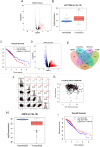MiR-196b Promotes the Invasion and Migration of Lung Adenocarcinoma Cells by Targeting AQP4
- PMID: 33455522
- PMCID: PMC8097310
- DOI: 10.1177/1533033820985868
MiR-196b Promotes the Invasion and Migration of Lung Adenocarcinoma Cells by Targeting AQP4
Abstract
Objective: We aimed to investigate the mechanism of the regulatory axis of miR-196b/AQP4 underlying the invasion and migration of lung adenocarcinoma (LUAD) cells.
Methods: LUAD miRNA and mRNA expression profiles were downloaded from TCGA database and then differential analysis was used to identify the target miRNA. Target gene for the miRNA was obtained via prediction using 3 bioinformatics databases and intersection with the differentially expressed mRNAs searched from TCGA-LUAD. Then, qRT-PCR and western blot were used to validate the expression of miR-196b and AQP4. Dual-luciferase reporter assay was performed to confirm the targeting relationship between miR-196b and AQP4. Transwell assay was used to investigate the migration and invasion of LUAD cells.
Results: MiR-196b was screened out by differential and survival analyses, and the downstream target gene AQP4 was identified. In LUAD, miR-196b was highly expressed while AQP4 was poorly expressed. Besides, overexpression of miR-196b promoted cell invasion and migration, while overexpression of AQP4 had negative effects. Moreover, the results of the dual-luciferase reporter assay suggested that AQP4 was a direct target of miR-196b. In addition, we also found that overexpressing AQP4 could suppress the promotive effect of miR-196b on cancer cell invasion and migration.
Conclusion: MiR-196b promotes the invasion and migration of LUAD cells by down-regulating AQP4, which helps us find new molecular targeted therapies for LUAD.
Keywords: AQP4; invasion; lung adenocarcinoma; miR-196b; migration.
Conflict of interest statement
Figures





Similar articles
-
miR-133b inhibits cell proliferation, migration, and invasion of lung adenocarcinoma by targeting CDCA8.Pathol Res Pract. 2021 Jul;223:153459. doi: 10.1016/j.prp.2021.153459. Epub 2021 Apr 28. Pathol Res Pract. 2021. PMID: 33971546
-
miR-196b-5p Promotes Proliferation, Migration and Invasion of Lung Adenocarcinoma Cells via Targeting RSPO2.Cancer Manag Res. 2020 Dec 29;12:13393-13402. doi: 10.2147/CMAR.S274171. eCollection 2020. Cancer Manag Res. 2020. PMID: 33402849 Free PMC article.
-
miR-21-5p promotes lung adenocarcinoma cell proliferation, migration and invasion via targeting WWC2.Cancer Biomark. 2020;28(4):549-559. doi: 10.3233/CBM-201489. Cancer Biomark. 2020. PMID: 32623387
-
miR-139-5p Inhibits Lung Adenocarcinoma Cell Proliferation, Migration, and Invasion by Targeting MAD2L1.Comput Math Methods Med. 2020 Nov 4;2020:2953598. doi: 10.1155/2020/2953598. eCollection 2020. Comput Math Methods Med. 2020. Retraction in: Comput Math Methods Med. 2023 Sep 27;2023:9789647. doi: 10.1155/2023/9789647. PMID: 33204298 Free PMC article. Retracted.
-
The role of aquaporin 4 in brain tumors: implications for pathophysiology, diagnosis and therapy.Mol Biol Rep. 2022 Nov;49(11):10609-10615. doi: 10.1007/s11033-022-07656-y. Epub 2022 Jun 17. Mol Biol Rep. 2022. PMID: 35715607 Review.
Cited by
-
AQP4 is an Emerging Regulator of Pathological Pain: A Narrative Review.Cell Mol Neurobiol. 2023 Nov;43(8):3997-4005. doi: 10.1007/s10571-023-01422-9. Epub 2023 Oct 21. Cell Mol Neurobiol. 2023. PMID: 37864629 Free PMC article. Review.
-
Expression Profiles of AQP3 and AQP4 in Lung Adenocarcinoma Samples Generated via Bronchoscopic Biopsies.J Clin Med. 2022 Oct 9;11(19):5954. doi: 10.3390/jcm11195954. J Clin Med. 2022. PMID: 36233821 Free PMC article.
-
miR-6742-5p regulates the invasion and migration of lung adenocarcinoma cells via mediating FGF8/ERK12/MMP9/MMP2 signaling pathway.Aging (Albany NY). 2023 Jan 10;15(1):53-69. doi: 10.18632/aging.204277. Epub 2023 Jan 10. Aging (Albany NY). 2023. PMID: 36629518 Free PMC article.
-
MicroRNA‑mediated regulation in lung adenocarcinoma: Signaling pathways and potential therapeutic implications (Review).Oncol Rep. 2023 Dec;50(6):211. doi: 10.3892/or.2023.8648. Epub 2023 Oct 20. Oncol Rep. 2023. PMID: 37859595 Free PMC article. Review.
-
Comprehensive Analysis of Aquaporin Superfamily in Lung Adenocarcinoma.Front Mol Biosci. 2021 Oct 11;8:736367. doi: 10.3389/fmolb.2021.736367. eCollection 2021. Front Mol Biosci. 2021. PMID: 34708074 Free PMC article.
References
-
- Torre LA, Bray F, Siegel RL, Ferlay J, Lortet-Tieulent J, Jemal A. Global cancer statistics, 2012. CA Cancer J Clin. 2015;65(2):87–108. doi:10.3322/caac.21262 - PubMed
-
- Jemal A, Bray F, Center MM, Ferlay J, Ward E, Forman D. Global cancer statistics. CA Cancer J Clin. 2011;61(2):69–90. doi:10.3322/caac.20107 - PubMed
-
- Hirsch FR, Scagliotti GV, Mulshine JL, et al. Lung cancer: current therapies and new targeted treatments. Lancet. 2017;389(10066):299–311. doi:10.1016/S0140-6736(16)30958-8 - PubMed
-
- Bender E. Epidemiology: the dominant malignancy. Nature. 2014;513(7517):S2–S3. doi:10.1038/513S2a - PubMed
-
- Travis WD, Brambilla E, Nicholson AG, et al. The 2015 World Health Organization classification of lung tumors: impact of genetic, clinical and radiologic advances since the 2004 classification. J Thorac Oncol. 2015;10(9):1243–1260. doi:10.1097/JTO.0000000000000630 - PubMed
MeSH terms
Substances
LinkOut - more resources
Full Text Sources
Other Literature Sources

